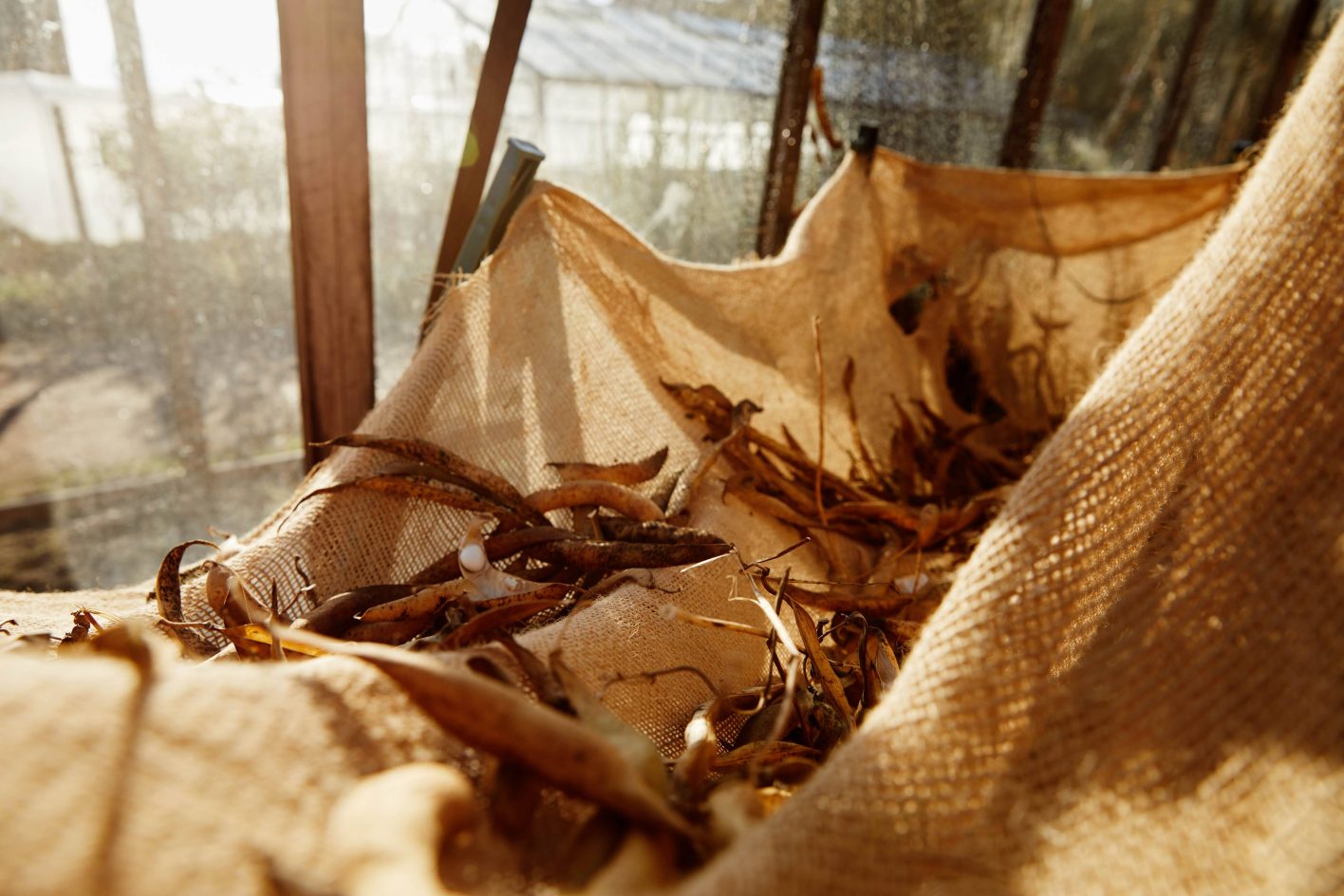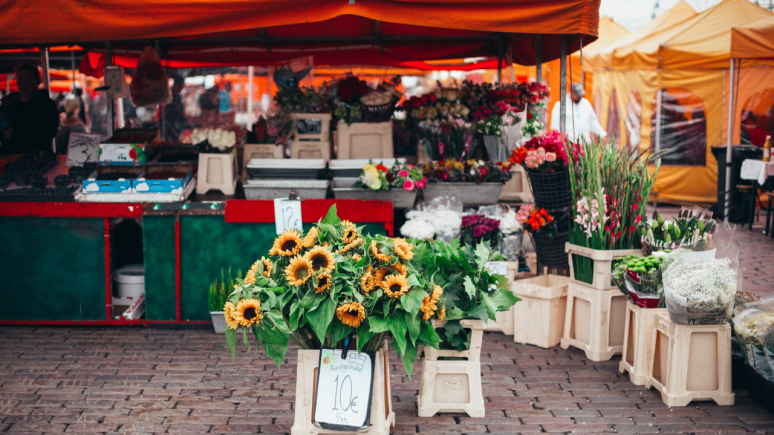
Seeds Breed Cooperation: The Power of Seed Sovereignty
By Katie Hastings, Wales Coordinator for the Seed Sovereignty Programme
When a plant produces seed, it does so in abundance. If you have ever harvested the bullet like seeds from a kale plant or found a bed of self-seeded calendula flowers pop up like unannounced orange fireworks from the soil, you will know that nature gives more seeds than she needs.
By design, people are meant to share seeds. Carried on the wind, stuck to the underbelly of a beast, passed from one community to another. Once you have started saving seeds, it’s practically impossible to keep them to yourself. To leave them packaged up in a personal stash feels wrong on some deep unspeakable level.
The Importance of Seed Saving
If we turn to the story of how humans have coevolved with our food crops, we will see that the vegetables and grains that exist in the world today are only here because of humans. Different to wild plants, cultivated crops have a history woven so deep into the story of human culture that it is impossible to unpick the characters. For many hundreds and thousands of years, seed saving closed the loop of the farming cycle. People grew crops, made selections for the traits they most desired, and saved seeds to start the process again the following year. Because each community grew and shared seeds in each region, the fields of the world were a patchwork of different crops. Each suited to the soils they grew in and the taste buds of the people eating them.
In the last century, people dropped the stitch that holds together this intricate tapestry of coevolution. 75% of the world’s crop diversity has been lost in the last 100 years. As our food systems have fast become industrialised, so to have our seed systems. It can be shocking to think about how quickly the skills of seed saving have disappeared from farms in such a short period of time. Just four corporations own 60% of the worlds seeds. A couple of generations ago it was normal to save locally adapted seed. People quickly ripped out this page in the story of farming. They replaced it with the idea that seed companies should centrally produce our seeds.

Seed Sovereignty
We could dwell on what we have lost. Or we could turn our attention to the sudden and hopeful germination of Seed Sovereignty. A movement pushing to reweave crop diversity back into our story. In 2017, the Seed Sovereignty Programme started working to build a more resilient seed system in the UK and Ireland. For seven years we have been standing with growers, farmers and seed activists. Facilitating seed production trainings, network building and local seed revival projects. Having trained 1,497 growers in seed production skills since 2020, we have seen a surge in seed diversity. With 105 new growers producing 322 new vegetable varieties and 18 new grain varieties commercially. In the same timeframe, we have supported 167 new community growers to produce 337 new vegetable and 88 new grain varieties in the UK and Ireland.
What is clear is that when we teach growers to produce seed, they naturally go on to build seed sharing networks. By training farmers in foundational seed saving skills and then supporting those farmers to connect with one another, we are creating the conditions for so much more to emerge. Over the last few years, there has been an upsurge of new community seed groups. Spreading across the UK, the likes of Glasgow Seed Library, Perthshire Seed Library, Incredible Edible Seed Library (South Wales), Seeds of Hope (Bradford) and Sow Northern mobile seed library are swelling the already plentiful ranks of grassroots seed networks. Where there are people saving seeds, there are people sharing seeds across their communities.
Seeds have memory
In more scientific terms, this memory is in the seed’s genetics. To have crops which thrive in our local regions, the seeds we are starting with need to contain a broad genetic foundation. Giving them the ability to thrive in the conditions our local climate might throw at them. Farmers in the UK import a large percentage of the seed grown from countries with vastly different climates to theirs. Many of these crop varieties just don’t have the genetic know how to flourish in specific bioregions different to the ones they have come from. Seeds produced in the favourable sunny conditions of Southern Spain will find it quite shocking to suddenly grow in the heavy damp clay soils of West Wales. When it comes to building a resilient seed system, it’s not a ‘one size fits all’ scenario. We need to be producing the seeds we need in the regions we want them to grow in.

The Wales Seed Hub
Leaning into this principle, I have been working alongside a group of fledgling seed producers to create a seed selling cooperative, the Wales Seed Hub. Running across multiple farms and smallholdings in Wales. Each grower is producing several seed crops for sale through the collective catalogue. In their fourth year selling seeds via their online shop, the Wales Seed Hub have gone from providing 2 new varieties for sale in 2020, to 40 new varieties for sale in 2024. In light of the huge decline in seed diversity over the last 100 years, bringing 40 new varieties back into Welsh circulation is far from insignificant. Imperatively, people grow all of these varieties in Wales. Therefore, they are already adapting to the growing conditions of the Western UK. Unlike seeds purchased from large seed companies, often grown in Spain or China, gardeners buying from the Wales Seed Hub get seeds grown in soils more appropriate and closer to home.
The Wales Seed Hub model is radical. Rather than operate as a centralised seed company, this cooperative focuses on decentralised seed growing. Each grower is responsible for tending their own crops. As well as harvesting and packaging their seeds into beautifully designed seed packets, the growers choose the varieties best suited to their soils and keep their own records. Once the seeds are off the plant, the collective takes responsibility for getting them out into the world. Marketing and promotion are done together. Quality control is a shared responsibility. The group operate one online shop and have one distribution point. Cooperation on this scale makes business sense. Wales Seed Hub members share jobs, giving growers more time to be in the fields producing precious seeds.

The Benefits of Cooperation
The benefits reach further and deeper than this. With all the Wales Seed Hub members having recently undergone training in seed production. They are able to pool their knowledge and share their learning as they move along the road to being professional seed sellers. Monthly meetings and regular communication allow growers to update one another on their crop progress and ask important cultivation questions of the collective. The coop has developed strict quality guidelines, offering each new member guidance on complex topics. These include isolation distances, population sizes and germination test rates. This kind of peer-to-peer learning model is what can really support the seed knowledge in this group grow to new heights. No longer reliant on top-down learning, the members of the Wales Seed Hub are advancing their seed growing skills as a flock.
Working Cooperatively
We can dig deeper still, to the root of why seed production is so suited to cooperative working. The plants themselves require us to cooperate. If you know anything about seed saving, you will know that in order to produce ‘true to type’ seed crops, you need to isolate plants from pollinating with any other varieties of the same species. This means that if you want to produce a kale seed crop, you must ensure your flowering kale is at least one mile from any other flowering Brassica of the same species (or encase the crop in an isolation cage). It is very difficult for a grower to produce more than one seed crop of each cross-pollinating species per year. What works far better is to work together, spreading crops across different pieces of land.
Crucially, once seeds have been grown in a patchwork, they need us bring them back together and spread them far and wide. We are the disseminators of food crop seeds and the cultivators of seed diversity. One kale seed crop has limited benefit to one grower, but distributing this kale amongst many farms in the same bioregion has an infinitely bigger impact. Seeds require isolated growing and collective sharing. It would seem that it is impossible to grow seeds without cooperation.

Decentralisation for Diverse Seeds
The Wales Seed Hub are demonstrating a decentralised seed model that can be replicated across the UK and Ireland. The Seed Sovereignty Programme are already working with groups in Northern England, Scotland and the South West of England. Helping them to create their own regional seed hubs. The beauty of working with seed diversity is that while the organising model can be the same, the seeds cultivated in those different regions will be beautifully bespoke to those conditions and human cultures.
And just like that, diverse seeds are finding their way back into our fields and gardens. Working together with humans, these seeds are finding pockets of people to grow them and circulate them. Despite the efforts of an industrialised seed system to control genetic diversity and move seeds away from common ownership, the seeds cannot be contained. Just as seeds are meant to be grown, they are meant to be shared. As seed diversity slowly takes back ground in an undercurrent across the UK and Ireland, groups of people working in cooperation are flowering around them.
If you would like to learn more about seed saving then watch our Earthed course “Saving Seeds for a Better Future” with Will Bonsall.


